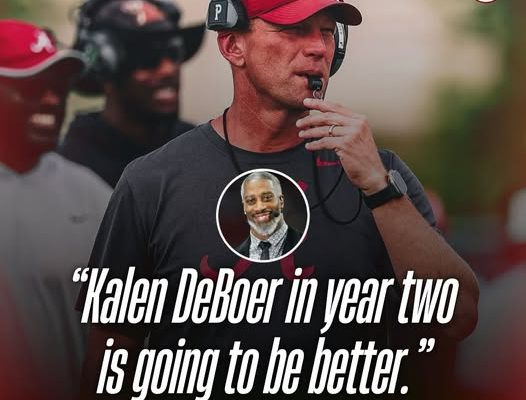Roman Harper, a former standout safety for the Alabama Crimson Tide and a two-time Super Bowl champion in the NFL, recently visited Tuscaloosa and left with a renewed sense of optimism about the direction of Alabama football heading into the 2025 season. Harper, who played under legendary coach Nick Saban during his college career, is no stranger to high expectations and the pressures that come with representing one of the most storied programs in college football history. His insight, rooted in both experience and a deep understanding of the Crimson Tide culture, carries weight with fans, analysts, and players alike. During his visit, Harper had the chance to observe practice sessions, meet with coaching staff, and speak directly with players. What struck him most was the evident growth in the team’s mindset and the tangible progress in key areas that have historically defined Alabama as a powerhouse in college football. He emphasized that while the program has always prioritized elite talent and rigorous preparation, what stood out to him in 2025 was a renewed balance between individual player development and collective team cohesion. Harper pointed out that seeing younger players step into leadership roles without hesitation was a clear indicator that the culture of accountability and excellence remains strong within the program. This balance, he noted, is critical for Alabama to sustain long-term success and maintain its competitive edge in the SEC and nationally. One of the key takeaways from Harper’s visit was his observation of the Crimson Tide’s defensive unit. Known during his playing days for his leadership and ability to read offenses, Harper was particularly impressed with the versatility and intelligence displayed by Alabama’s defensive backs. He highlighted how the current crop of safeties and cornerbacks demonstrates a high football IQ, adaptability in coverage schemes, and the physicality needed to dominate at the collegiate level. Harper mentioned that these qualities were reminiscent of the traits that made Alabama defenses dominant during his tenure, but with a modern edge that aligns with evolving offensive strategies in college football. Harper also noted the offensive improvements and the overall strategic depth the team is showcasing. While Alabama has consistently been recognized for its high-powered offenses, Harper observed that the 2025 iteration of the Crimson Tide has placed a renewed emphasis on precise execution, situational awareness, and minimizing errors in critical moments. He cited the quarterback play, skill position depth, and offensive line cohesion as areas that instill confidence in the team’s ability to sustain drives, capitalize on opportunities, and withstand the physical grind of a demanding SEC schedule. Beyond on-field performance, Harper was struck by the professionalism and maturity displayed by the coaching staff. He praised the ability of head coach Nick Saban and his assistants to foster an environment where young athletes are not only trained physically but also mentally equipped to handle the pressures of college football. Harper emphasized that this holistic approach to player development is what separates Alabama from many other programs, ensuring that talent is complemented by preparation, discipline, and an understanding of the game at the highest level. Another element that contributed to Harper’s confidence was the evident depth across the roster. Injuries, departures, and other challenges are inevitable over the course of a season, but Harper noticed that Alabama has cultivated a talent pipeline that allows players to seamlessly step into critical roles without the team losing momentum. This depth, combined with strategic recruiting, ensures that the Crimson Tide remains competitive regardless of the circumstances, a factor Harper believes will be pivotal in 2025 as the team navigates a grueling schedule with numerous high-stakes matchups. Harper also commented on the team’s attitude during practice sessions. He highlighted the intensity, focus, and mutual respect among teammates as indicators of a strong, cohesive unit. According to Harper, witnessing players hold each other accountable while simultaneously encouraging growth and performance reflects a program culture that prioritizes both personal and collective responsibility. This intangible quality, Harper noted, often makes the difference in close games and can be a defining factor in championship pursuits. Harper’s discussions with players revealed his appreciation for their mindset and approach to competition. He found that many of the younger athletes are not merely chasing individual accolades but are committed to contributing to the team’s overarching goals. This mindset, he argued, mirrors the ethos that has defined Alabama football for decades—where success is measured not just by individual statistics, but by the team’s ability to perform consistently at the highest level. In addition, Harper observed that the Crimson Tide has embraced technological advancements and modern training techniques to enhance performance. From analytics-driven approaches to skill development to strength and conditioning regimens designed to maximize resilience and minimize injuries, Harper noted that the program has successfully integrated innovation with tradition. He believes this combination is key to sustaining Alabama’s competitive advantage, allowing players to reach peak performance while remaining grounded in the fundamental principles that have historically defined the program. Harper also touched on the fan base and community support, noting that Alabama’s culture extends far beyond the practice field and stadium. He recognized that the commitment, passion, and engagement of the fans create an environment that motivates players and staff alike. Harper believes that this support system, coupled with the program’s internal focus on excellence, creates a synergistic effect that elevates performance and fosters a sense of pride and responsibility among all members of the team. While Harper acknowledged that no season comes without challenges, his overall assessment of Alabama football heading into 2025 was highly positive. He emphasized that the combination of talent, preparation, depth, coaching, and culture has him more confident than ever in the team’s ability to compete for championships. Harper’s perspective carries weight because of his own experiences navigating the pressures of high-level football, both at Alabama and in the NFL, and his observations suggest that the Crimson Tide is not only maintaining its standards but also evolving to meet the demands of modern college football. Harper concluded that the 2025 Crimson Tide team embodies the traits that have historically made Alabama a perennial powerhouse while also demonstrating adaptability, resilience, and leadership that signal a bright future. His confidence stems from seeing a program that is deeply committed to excellence at every level—physically, mentally, and strategically. The combination of a skilled roster, effective coaching, and a culture that emphasizes accountability, unity, and continuous improvement left Harper reassured that Alabama football is well-positioned for success in the upcoming season. His visit to Tuscaloosa serves as a reminder to fans, players, and analysts alike that the Crimson Tide remains a dominant force, capable of not only meeting expectations but exceeding them through careful preparation, disciplined execution, and an unwavering commitment to the program’s values. In the weeks leading up to the start of the 2025 season, Harper’s insights provide a lens through which the program’s trajectory can be assessed. He stressed that while talent is essential, the cohesion of the team, the strategic acumen of the coaching staff, and the commitment to personal and collective growth are what ultimately define success. Harper’s firsthand observations suggest that Alabama football is in a position to leverage all of these factors to compete at the highest level, maintain its status as a national contender, and continue its legacy of excellence. Fans in Tuscaloosa and beyond can take solace in the fact that one of the program’s distinguished alumni sees not just potential, but a realistic path to continued dominance. Harper’s confidence is not rooted in wishful thinking but in careful observation, analysis, and a deep understanding of what it takes to win consistently in college football. As Alabama prepares for the 2025 season, the endorsement of Roman Harper adds another layer of optimism, reinforcing the notion that the Crimson Tide remains at the pinnacle of the sport and is poised to build on its historic success. For players, staff, and fans alike, Harper’s visit serves as both validation of hard work and motivation to maintain the standards that have long defined Alabama football. His reflections highlight the importance of leadership, preparation, and culture in sustaining excellence, and they underscore why Alabama continues to be a model program in the ever-evolving landscape of college football. Harper’s confidence in Alabama’s future is a testament to the enduring strength of the program and a reminder that, even as the game evolves, the Crimson Tide remains steadfast in its pursuit of excellence and championships. As the 2025 season approaches, the excitement in Tuscaloosa is palpable, fueled by the knowledge that a program steeped in tradition and driven by innovation is ready to compete at the highest level, with Roman Harper’s stamp of approval serving as a compelling signal that the future is bright for Alabama football.
Roman Harper left Tuscaloosa feeling MORE confident about Alabama football going into 2025.



